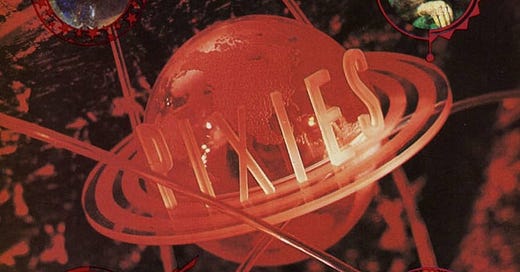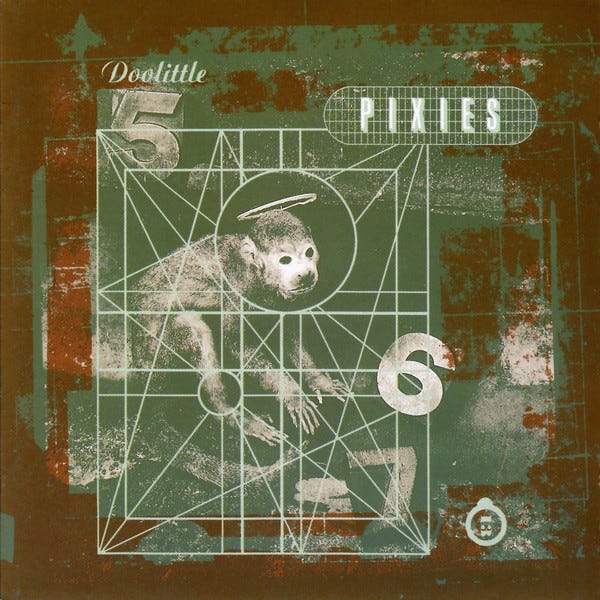Currently touring Europe, performing their 1990s albums Bossanova and Trompe Le Monde in full Pixies began a new phase of their career with the release of Bossanova in 1990. It marked the point where they progressed from lyrics focused on biblical harlots to UFOs and aliens.
Chained to the pillars
There is very little doubt in my mind that 1989’s Doolittle by Pixies is one of my favourite albums of all time. What the band do well is evident on many tracks on their second full album but for me, the opening and closing songs, ‘Debaser’ and ‘Gouge Away’ showcase their talents at the highest echelon. Both pieces are examples of the band’s members per…
Several tracks on the album explicitly reference space and sci-fi themes, such as ‘The Happening’, which alludes to a UFO sighting in Las Vegas, and ‘Ana’ contains references to space with lines like "we're going surfin' on the moon." The overall sound of Bossanova, with its reverb-drenched guitars and expansive production, also contributes to the spacey, otherworldly atmosphere that reflects Black Francis' interest in such subjects.
While not lyrically focusing on little green men, ‘Havalina’, the closing track, does have an ethereal simplicity and haunting otherworldly beauty, contrasting with the more dynamic and aggressive tone that characterised much of the Pixies' work in the late 1980s and even on the rest of the album. There’s a deep sense of irony here, of course; just as the band turned away from the raw and abrasive, it became the next big thing with grunge and the releases of Ten by Pearl Jam and Nirvana’s Nevermind 12 and 13 months away, respectively.
With Bossanova, the band leaned more heavily into surf rock and dreamy, space-themed aesthetics under Gil Norton's production. This shift is evident in cleaner production, more reverb, and a broader sonic palette, setting the stage for the dreamlike quality of ‘Havalina’. Assumedly, there is no guitar playing with razor blades on this record.
The song is named after a wild pig found in the Americas, the javelina. Its lyrics are minimalistic and cryptic, painting a vivid picture of two individuals walking through the deserts and forests of Arizona and encountering a javelina - what an English speaker might call a Peccary. Indeed, as Kim Deal told Melody Maker, Francis and his girlfriend were the inspiration.
Havalina, the album’s closing song, was composed after Charles and his girlfriend were chased by a wild pig in Arizona. So he decided to write a real pretty love song.
Black Francis also told Q.
Havalina is apparently the Mexican name for a wild boar and has nothing to do with the band of that name – who did, however, get The Pixies stoned in Texas. Helped us out in a very dry period.
The instrumentation is sparse yet atmospheric, with Joey Santiago's guitar work and the rhythm section of David Lovering and Deal creating a drifting, almost hypnotic soundscape that mirrors the song's desert imagery. The rhythm of this track’s jangly guitars and drums sounds slightly unusual, as if it's somewhat off. Black Francis shed light on this in a 1991 interview with Melody Maker;
“Havalina” was the most difficult of those songs to record. It’s in 6/4. We wanted David to do fills in 4/4, but he couldn’t because he was listening to us. We ended up playing a bunch of chords in 4, had David do the fills, and then we recorded our real parts in 6.
That, of course, doesn’t take away from this being the most beautiful song in the band’s back catalogue, a real Ronnie O’Sullivan playing left-handed effort that they did because they can, showing up anyone who tried to write songs like that all the time.
For a band that took on the advice of Norton and a copy of Buddy Holly’s greatest hits and wheeled through fifteen songs in 38 minutes on Doolittle yet packed in dense, snappy and snarky dialogue-like lyrics, ‘Havalina’ is a real change of pace, longer than half the songs on their previous album it contains about a dozen lines and most of the runtime is the spectral coo of the title. It shows a band that had the bravery to turn away from the element that made them unique just as the rest of the world was cottoning on to their loudQUIETloud dynamic; they send us away whispering sweetly in our ear.






Agreed, always loved this track!
Huge fan of the Pixies! Thanks for the link to an older post here!